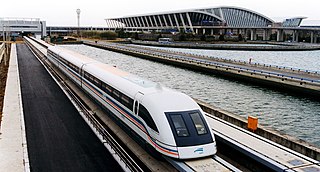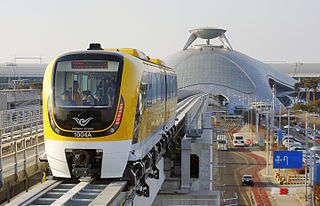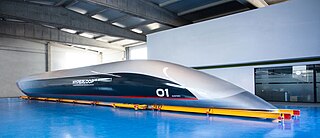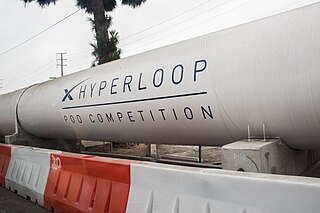
Transrapid is a German-developed high-speed monorail train using magnetic levitation. Planning for the system started in the late 1960s, with the a test facility in Emsland, Germany inaugurated in 1983. In 1991, technical readiness for application was approved by the Deutsche Bundesbahn in cooperation with renowned universities.
Inductrack is a passive, fail-safe electrodynamic magnetic levitation system, using only unpowered loops of wire in the track and permanent magnets on the vehicle to achieve magnetic levitation. The track can be in one of two configurations, a "ladder track" and a "laminated track". The ladder track is made of unpowered Litz wire cables, and the laminated track is made out of stacked copper or aluminium sheets.

Maglev is a system of rail transport whose rolling stock is levitated by electromagnets rather than rolled on wheels, eliminating rolling resistance.

The Shanghai maglev train (SMT) or Shanghai Transrapid is a magnetic levitation train (maglev) line that operates in Shanghai, China. The line uses the German Transrapid technology. The Shanghai maglev is the world's first commercial high-speed maglev and has a maximum cruising speed of 300 km/h (186 mph). Prior to May 2021 the cruising speed was 431 km/h (268 mph), at the time this made it the fastest train service in commercial operation.

Electromagnetic suspension (EMS) is the magnetic levitation of an object achieved by constantly altering the strength of a magnetic field produced by electromagnets using a feedback loop. In most cases the levitation effect is mostly due to permanent magnets as they have no power dissipation, with electromagnets only used to stabilise the effect.

The SCMaglev is a magnetic levitation (maglev) railway system developed by Central Japan Railway Company and the Railway Technical Research Institute.
A vactrain is a proposed design for very-high-speed rail transportation. It is a maglev line using partly evacuated tubes or tunnels. Reduced air resistance could permit vactrains to travel at very high (hypersonic) speeds with relatively little power—up to 6,400–8,000 km/h (4,000–5,000 mph). This is 5–6 times the speed of sound in Earth's atmosphere at sea level.

A ground effect train is a conceptualized alternative to a magnetic levitation (maglev) train. In both cases the objective is to prevent the vehicle from making contact with the ground. Whereas a maglev train accomplishes this through the use of magnetism, a ground effect train uses an air cushion; either in the manner of a hovercraft or using the "wing-in-ground-effect" design.

Plans for high-speed rail in the United States date back to the High-Speed Ground Transportation Act of 1965. Various state and federal proposals have followed. Despite being one of the world's first countries to get high-speed trains, it failed to spread. Definitions of what constitutes high-speed rail vary, including a range of speeds over 110 mph (180 km/h) and dedicated rail lines. Inter-city rail with top speeds between 90 and 125 mph is sometimes referred to in the United States as higher-speed rail.

Skytran is a personal rapid transit system concept. It was first proposed by the inventor Douglas Malewicki in 1990 and was under development by Unimodal Inc. A prototype of the skyTran vehicle and a section of track have been constructed. The early magnetic levitation system, Inductrack, which SkyTran has replaced with a similar proprietary design, has been tested by General Atomics with a full-scale model. In 2010, Unimodal signed an agreement with NASA to test and develop skyTran. skyTran had proposed additional projects in France, Germany, India, Indonesia, Malaysia, the United Kingdom, and the United States.

Indian Railways operates India's railway system and comes under the purview of the Ministry of Railways of Government of India. As of 2023, it maintains over 108,706 km (67,547 mi) of tracks and operates over 13,000 trains daily. According to the Ministry of Railways, a route capable of supporting trains operating at more than 160 km/h (100 mph) is considered as a higher speed or semi-high speed rail line.

The Transportation Technology Center (TTC) is a railroad equipment testing and training facility located northeast of Pueblo, Colorado, owned by the Federal Railroad Administration (FRA). It was built in 1971 as the High Speed Ground Test Center (HSGTC) for the Department of Transportation (DOT) and its original purpose was to test several hovertrain concepts. When those projects were completed in the 1970s, the site was handed to the FRA.

The Incheon Airport Maglev was a maglev line in South Korea that opened on 3 February 2016 and closed on 1 September 2023. It was the world's second commercially operating unmanned urban maglev line after Japan's Linimo. The trains were lighter, cutting construction costs in half. The majority of construction was completed by November 2012.

Magnetic levitation (maglev) or magnetic suspension is a method by which an object is suspended with no support other than magnetic fields. Magnetic force is used to counteract the effects of the gravitational force and any other forces.

Hyperloop is a proposed high-speed transportation system for both passengers and freight. The concept was documented by Elon Musk in a 2013 white paper, where the hyperloop was described as a transportation system using capsules supported by an air-bearing surface within a low-pressure tube. Hyperloop systems have three essential elements: tubes, pods, and terminals. The tube is a large, sealed low-pressure system. The pod is a coach at atmospheric pressure that experiences low air resistance or friction inside the tube using magnetic propulsion. The terminal handles pod arrivals and departures. The hyperloop, in the form proposed by Musk, differs from tradititional vactrains by relying on residual air pressure inside the tube to provide lift from aerofoils and propulsion by fans; however, many subsequent variants using the name "hyperloop" have remained relatively close to the core principles of vactrains.

Hyperloop Transportation Technologies, also known as HyperloopTT, is an American research company formed using a crowd collaboration approach to develop around the world commercial transportation systems based on the Hyperloop concept.

Hyperloop One, known as Virgin Hyperloop until November 2022, was an American transportation technology company that worked to commercialize high-speed travel utilizing the Hyperloop concept which was a variant of the vacuum train. The company was established on June 1, 2014, and reorganized and renamed on October 12, 2017.

The Hyperloop Pod Competition was an annual competition sponsored by SpaceX from 2015 to 2019 in which a number of student and non-student teams participated to design—and for some teams, build—a subscale prototype transport vehicle in order to demonstrate technical feasibility of various aspects of the Hyperloop concept. The competitions were open to participants globally, although all competitions and judging occurred in the United States of America.
TransPod Inc. is a Canadian company designing ultra-high-speed transportation technology and vehicles.